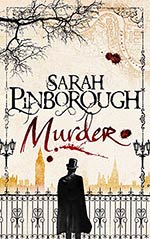
![]() Nymeria
Nymeria
12/24/2015
![]()
If Mayhem, the previous book in this fascinating series, had its roots in the darkness generated by human wickedness and by supernatural forces, Murder stands mostly on the horror of a soul headed on a downward spiral to Hell. For this very reason it's more terrifying than its predecessor, even though the gorier elements are kept to a minimum: the hopelessness and unavoidable evil permeating the pages are far worse than the trail of body parts that was the focus of Mayehm, or the number of little children's bodies that are fished out of the Thames here.
Dr. Thomas Bond, the main character, has worked hard to overcome the psychological wounds incurred during the investigation of the "Torso Murders" and the hunt for the Upir, the infernal creature attaching itself to hapless victims and forcing them to commit atrocious deeds: he's weaned himself of the dependence for opium and laudanum, and in helping young widow Juliana to deal with her grief has created the possibility for a shared future alongside the woman he's been in love with for a long time. But as it often happens with the best laid plans, the past comes back to haunt the good doctor in a way that seems quite unthreatening in the beginning but will have gruesome repercussions along the road.
This turn of events appears even more tragic because of the small shard of happiness that seems to be within Bond's grasp and is instead taken from him bit by cruel bit: the appearance of a contender for Juliana's attention is the lesser of those evils, and yet it's such a blow for him, for this lonely man who dares to dream of a better future for himself, one that would give him a new lease on life after the harrowing experiences of the recent past and the burden of guilt that comes with them. The Thomas Bond of Murder reads like a very different person, one who is ultimately far more unhinged and prone to darkness now - when he has shaken off his drug dependencies and has reached a sort of inner balance - than he was in book 1, when he was tormented by his own feelings of inadequacy and the suffocating sense of doom that hung over him. For this very reason he looks far more human, frail and flawed than before, and he shows that humanity by giving in to less than noble feelings: there is a quiet desperation to him, that of the man who wants to be good and finds himself unable to attain his own self-imposed goals. Much as he tries to escape the ghosts plaguing him, he discovers they are still able to find him and to haunt both his dreams and his waking hours.
And this is just the beginning: by a sudden and quite unexpected narrative twist, Bond is thrown into deepening darkness and despair, a chain of tragic and unstoppable circumstances that Pinborough links with flawless mastery to historical events, the chronicled reality of facts and people adding to the drama unfolding in the fictional part of the story. Bond's progressive physical and mental deconstruction is rendered with great poignancy through his first-person chapters, where he analyzes - as the man of science he is - what is happening around him and to him: if the certainties offered by that same science are a flimsy shield indeed, only we readers are aware of it, and this increases the painful sympathy we feel for this character who goes on bent on ignoring, at least for a while, his impending doom.
The quiet strength of this man is revealed by the way he chooses to fight what he subconsciously knows to be a losing battle, and yet he does everything in his power to keep on struggling, to avoid giving in to the darkness trying to engulf him. Even in the face of the most horrible revelations, even when I felt that he was avoiding the truth through convenient dissembling, my compassion for Thomas Bond never wavered, and this shows the extent of the author's skill in walking a very fine line between contrasting emotions. To say that I was psychologically exhausted by the end of the book would be quite an understatement.
On a lighter note, I enjoyed very much the recreation of the period atmosphere through the exchanges between characters, the way they were shaped by the social customs of the years bridging the 19th and 20th Century, and the interludes offered by the newspapers clippings inserted here and there. These details bring London in sharp, three-dimensional relief, making it another character instead of the mere background in which the story takes place and the same happens with the other figures appearing on the scene, both the fictional and the historical ones. Between the lines there is even room for understated, but clear, social commentary that adds another note of interest for a book that offers many angles of approach for a reader - not least the curiosity of knowing more about the real people behind the characters that make their appearance in the story.
If you're not afraid of a hard, dark journey, this will prove an involving, fascinating book. One that leaves the door open for more: the last newspaper clipping speaks of a grisly murder perpetrated one century after the facts portrayed here - much closer to our times. I guess Ms. Pinborough is daring us to open that door a bit more and peer into those murky shadows...
http://spaceandsorcery.wordpress.com